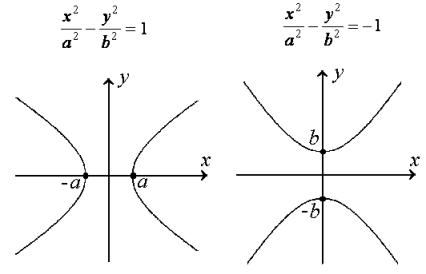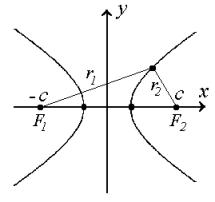A hyperbola is a plane curve, which can be represented by one of the equations
|
(7)
|
in some Cartesian coordinate system.

Equations (7) are called the canonical equations of the hyperbola.
In this system, the coordinate axes are axes of symmetry, and so if a point (x,y) belongs to the hyperbola then the points (-x,y), (x,-y) and (-x,-y) also belong to the hyperbola.
The intersection points of the hyperbola with the axis of symmetry are called the vertices of the hyperbola. Any hyperbola has two vertices.
If a = b then the hyperbola is called an equilateral hyperbola.
The equations

describe hyperbolas with the center is at the point ![]() . The axes of symmetry of these hyperbolas
pass through
. The axes of symmetry of these hyperbolas
pass through ![]() , being parallel to the coordinate
axes.
, being parallel to the coordinate
axes.
Consider a hyperbola, which is given by the equation
|
(8)
|
Two fixed points, ![]() and
and ![]() , are called the focuses
of the hyperbola, where
, are called the focuses
of the hyperbola, where ![]() .
.
Correspondingly, the distances r1 and r2 from any point M(x,y) of the hyperbola to the points F1 and F2 are called the focal distances.

The ratio ![]() is called the eccentricity
of hyperbola.
is called the eccentricity
of hyperbola.
Note that ![]() .
.

 .
.